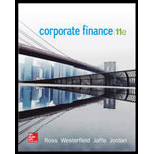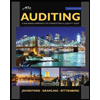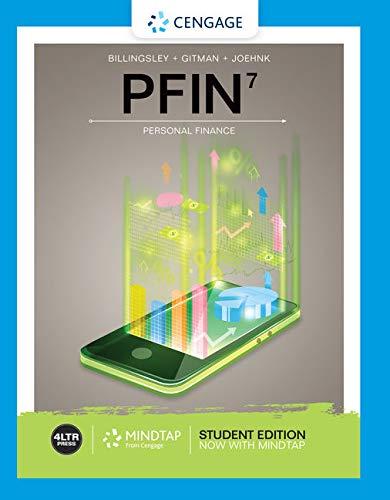
To explain: Financial distress using the stock-based and flow-based approaches.
Financial Distress:
Financial distress is a situation where the funds or revenue generated by the company through its cash flow activities is not sufficient to meet its current business obligations. It is the situation when the firm is not being able to pay its debts because neither the operating nor financing and nor the investing activities of the company are able to meets its obligations and run its business smoothly. Therefore, the acute shortage or lack of funds leads to financial vacuum being created in the firm which is known as financial distress.
Answer to Problem 1CQ
- Although financial distress can generally be taken as lack of funds to fuel, the activities of the business but there are two different approaches to analyze the financial distress. The first is the stock-based financial distress. In the stock based financial distress the assets of the company are relatively of lesser value than the value of company’s debts.
- This situation of excessive debt than the available assets leads to negative net worth of the company, which ultimately leads to the inability to meet any kind of obligations and a pressure, or distress of shortage of finance is created.
- Flow-based financial distress is a situation whereby the revenue generated by the operating activities of the business is not ample to meet the current debt obligations of the company. The operating activities are the core activities of the business and lack of revenue through the same reflects the poor performance of the business.
Explanation of Solution
- Financial distress means the situation where the funds generated by the company through its different business activities are not sufficient to meet the business obligations and eventually the business faces a vacuum of funds.
- Financial distress through stock based approach is a situation where the actual assets’ value held by the company is relatively lower than the liabilities faced by it.
- Flow-based financial distress directly displays the poor performance of the operating activities of the business and that the funds generated by it are insufficient to meet its current debt obligation.
Thus, the above mentioned are the different approaches of financial distress.
Want to see more full solutions like this?
Chapter 30 Solutions
Corporate Finance (The Mcgraw-hill/Irwin Series in Finance, Insurance, and Real Estate)
- Pfizer Pharmecuticals has a $21,000 par value bond outstanding that pays 10 percent annual interest. The current yield to maturity on such bonds in the market is 13 percent. Compute the price of the bonds for the following maturity dates: a. 30 years b. 15 yearsarrow_forwardPurina Pet Food earned $74 million last year and paid out 20 percent of earnings in dividends. a. By how much did the company's retained earnings increase? b. With 36 million shares outstanding and a stock price of $18, what was the dividend yield?arrow_forwardProfessor Brown has just retired after 25 years with Jessup University. Her total pension funds have an accumulated value of $504,000, and her life expectancy is 25 more years. Her pension fund manager assumes he can earn a 9 percent return on her assets. What will be her yearly annuity for the next 25 years?arrow_forward
- Caroline Moore has a contract in which she will receive the following payments for the next four years: $10,000, $11,000, $9,000, and $8,000. She will then receive an annuity of $13,000 a year from the end of the 4th through the end of the 10th year. The appropriate discount rate is 11 percent. What is the percent value of all future payments?arrow_forwardNick Weber wants to have $120,000 at the end of 10 years, and his only investment outlet is an 8 percent long-term certicate of deposit (compounded annually). With the certificate of deposit, he made an initial investment at the beginning of the year year. How much does Nick need to deposit to get the $120,000 at the end of 10 years. a. What amount could Nick pay at the end of each year annually for 10 years to achieve this same objective?arrow_forwardHigh Hand Nursery has total assests of $900,000, current liabilities of $202,000, and long-term liabilities of $104,000. There is $90,000 in preferred stock outstanding. Twenty thousand shares of common stock have been issued. a. Compute book value (net worth) per share. b. If there is $40,000 in earnings available to common stockholders for dividends, and the firm's stock has a P/E of 22 times earnings per share, what is the current price of the stock? c. What is the ratio of market value per share to book value per share?arrow_forward
- Need the WACC % WACC and Optimal Capital Structure F. Pierce Products Inc. is considering changing its capital structure. F. Pierce currently has no debt and no preferred stock, but it would like to add some debt to take advantage of the tax shield. Its investment banker has indicated that the pre-tax cost of debt under various possible capital structures would be as follows: Market Debt-to-Value Ratio (wd) Market Equity-to-Value Ratio (ws) Market Debt-toEquity Ratio (D/S) Before-Tax Cost ofDebt (rd) 0.0 1.0 0.00 6.0 % 0.10 0.90 0.1111 6.4 0.20 0.80 0.2500 7.0 0.30 0.70 0.4286 8.2 0.40 0.60 0.6667 10.0 F. Pierce uses the CAPM to estimate its cost of common equity, rs, and at the time of the analaysis the risk-free rate is 5%, the market risk premium is 7%, and the company's tax rate is 25%. F. Pierce estimates that its beta now (which is "unlevered" because it currently has no debt) is 1.4. Based on this information, what…arrow_forwardNed's Co. has an average collection period of 45 days and an operating cycle of 130 days. It has a policy of keeping at least $10 on hand as a minimum cash balance, and has a beginning cash balance for the first quarter of $20. Beginning receivables for the quarter amount to $35. Sales for the first and second quarters are expected to be $110 and $125, respectively, while purchases amount to 80% of the next quarter's forecast sales. The accounts payable period is 90 days. What are the cash disbursements for the first quarter? Question 4 options: $92 $88 $76 $100 $110arrow_forwardLiberal credit terms for customers is associated with a restrictive short-term financial policy. Question 3 options: True Falsearrow_forward
- An accounts payable period decrease would increase the length of a firm's cash cycle. Consider each in isolation. Question 6 options: True Falsearrow_forwardWhich of the following is the best definition of cash budget? Question 10 options: Costs that rise with increases in the level of investment in current assets. A forecast of cash receipts and disbursements for the next planning period. A secured short-term loan that involves either the assignment or factoring of the receivable. The time between sale of inventory and collection of the receivable. The time between receipt of inventory and payment for it.arrow_forwardShort-term financial decisions are typically defined to include cash inflows and outflows that occur within __ year(s) or less. Question 9 options: Four Two Three Five Onearrow_forward
 Auditing: A Risk Based-Approach to Conducting a Q...AccountingISBN:9781305080577Author:Karla M Johnstone, Audrey A. Gramling, Larry E. RittenbergPublisher:South-Western College Pub
Auditing: A Risk Based-Approach to Conducting a Q...AccountingISBN:9781305080577Author:Karla M Johnstone, Audrey A. Gramling, Larry E. RittenbergPublisher:South-Western College Pub Intermediate Financial Management (MindTap Course...FinanceISBN:9781337395083Author:Eugene F. Brigham, Phillip R. DavesPublisher:Cengage Learning
Intermediate Financial Management (MindTap Course...FinanceISBN:9781337395083Author:Eugene F. Brigham, Phillip R. DavesPublisher:Cengage Learning Pfin (with Mindtap, 1 Term Printed Access Card) (...FinanceISBN:9780357033609Author:Randall Billingsley, Lawrence J. Gitman, Michael D. JoehnkPublisher:Cengage Learning
Pfin (with Mindtap, 1 Term Printed Access Card) (...FinanceISBN:9780357033609Author:Randall Billingsley, Lawrence J. Gitman, Michael D. JoehnkPublisher:Cengage Learning EBK CONTEMPORARY FINANCIAL MANAGEMENTFinanceISBN:9781337514835Author:MOYERPublisher:CENGAGE LEARNING - CONSIGNMENT
EBK CONTEMPORARY FINANCIAL MANAGEMENTFinanceISBN:9781337514835Author:MOYERPublisher:CENGAGE LEARNING - CONSIGNMENT Intermediate Accounting: Reporting And AnalysisAccountingISBN:9781337788281Author:James M. Wahlen, Jefferson P. Jones, Donald PagachPublisher:Cengage Learning
Intermediate Accounting: Reporting And AnalysisAccountingISBN:9781337788281Author:James M. Wahlen, Jefferson P. Jones, Donald PagachPublisher:Cengage Learning





